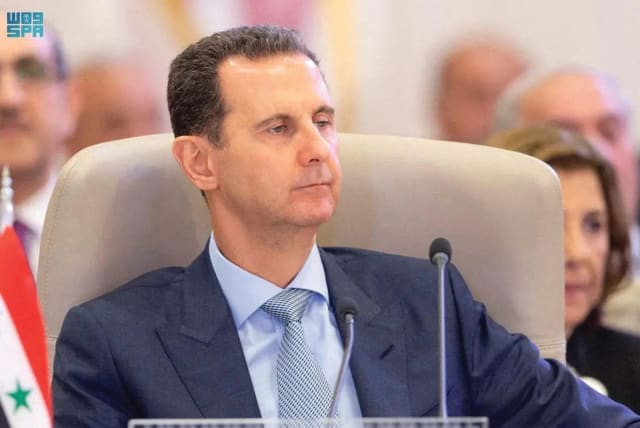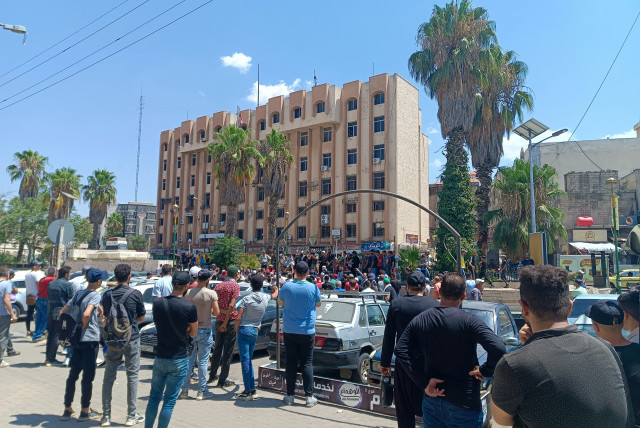Druze protest Assad in Southern Syria, fueled by economic desperation, security challenges

Citizens accuse the government of negligence in resolving the region’s issues.
Residents of the Druze-majority governorate of Sweida in southwest Syria demonstrated against the government through the weekend, protesting the deteriorating economic situation and a surge in fuel prices. Over 20 small protests throughout the area were accompanied by a general strike and road closures.
“Long live Syria and down with Assad,” protestors chanted during the demonstrations.
Taim (not his real name), a resident of Sweida, told The Media Line that on top of the economic crisis and poor living conditions, the people from the region feel that the government has failed to look after it.
“They are neglecting the area. They do not care about [Sweida]. They say they care, but the government does not care. It gives bits and pieces just to keep us calm,” he said.
Druze community in Syria
The Druze community in Syria constitutes about 3% of the country’s population and is located mainly in the south. Throughout history, the Druze community in Syria has maintained significant engagement with the Ba’ath Party, an Arab-socialist political faction associated with both President Bashar Assad and his predecessor, former President Hafez Assad. Nevertheless, during Hafez Assad’s tenure, the Druze community distanced itself from the party. Subsequently, when Bashar Assad assumed power in 2000, the Druze community exhibited a partial realignment with the party, and even some of them supported him during the civil war that began in 2011.
“When Assad came to power, things were changing for good in the beginning. There was nothing against him, in a way [people] said they loved him,” Taim said.
But the situation has changed, due to the poor life quality the Druze of Sweida are experiencing and the sense of the government’s negligence toward solving their hardships.
“Now you go down to the streets and ask people, everybody is cursing him. They don’t like him anymore. Even the people who supported them during this war now do not, because they are suffering,” Taim said, pointing out that many may still be afraid to publicly criticize Assad.
Valeria Scuto, principal analyst on the Middle East, North Africa and Turkey at Sibylline Ltd., a strategic advisory firm, says that the trigger for these recent protests was a hike in fuel prices after the announcement of subsidy cuts earlier this month, which also resulted in a significant drop in the Syrian pound.
However, she tells The Media Line that these protests are not necessarily a new development.
“They are broadly consistent with similar bouts of unrest observed in December 2022 in the Sweida governorate and are symptomatic of the growing discontent over Assad’s government and the worsening socioeconomic conditions over the past years,” Scuto said.
Hamza (name changed), another citizen of Sweida, explains that his city especially suffers from the rise in fuel prices due to its agricultural nature and small-town status, as it relies heavily on sourcing its necessities from other provinces.
“With the rising fuel costs, drought, and the inability to market agricultural products, citizens are finding it increasingly challenging to cope,” he told The Media Line, adding that this is particularly exacerbated by the absence of factories, companies, or tourism in the city, which creates a lack of income alternatives.
According to Hamza, Sweida currently relies entirely on remittances from its expatriate community abroad. Taim explained that many of this governorate’s citizens abroad are living either in Latin America or working in the Gulf.
“Every house has one or two people that are living outside of Syria, so they can send money to them,” he said.
But the economic situation of the local people has deteriorated to an extreme.
“There is no milk for the kids, and even if it’s available, it’s very expensive and people cannot even purchase it. They cannot even [travel] to their jobs. It’s more expensive to go to your job than your monthly wage,” Taim said.
In addition to the economic hardship, security is also an issue that Sweida’s population must confront. Hamza says that the phenomenon of the proliferation of armed elements in the form of road-blocking gangs is common in the area.
“These groups engage in violence, including the killing and kidnapping of residents, stealing cars and homes, and demanding tributes from merchants,” he said, adding that many of them have ties to internal security agencies or external entities to facilitate smuggling.
Taim adds that people that live in south Sweida suffer also from the drug industry originating in southern Lebanon.
Scuto reports recent additional demonstrations in Assad’s strongholds, including protests by taxi and bus drivers in the capital Damascus last week. These further highlight growing public discontent and socioeconomic grievances.
As in other areas controlled by the Syrian government, “resources to improve living conditions in Sweida remain limited, undermining efforts to defuse tensions in the near term and sustaining the risk of further unrest,” she said.
“I think we are likely to observe harsh security measures should these protests see a further uptick in the coming week, as in December 2022,” Scuto noted.
She argues that the increasingly recurrent nature of protest activity will sustain the likelihood of government forces carrying out arbitrary arrests and the use of live ammunition by security forces to disperse demonstrators.
Despite the fact that the Druze population has been considered a politically sensitive minority by the government, with the Druze having remained largely neutral on Assad, Scuto maintains that there have been growing signs of restlessness since 2018. Incidents of Druze youth absconding from their military service illustrate this.
According to her, the Assad regime will take note especially of the fact that the demonstrators revived chants from the Syrian Revolution and that similar protests took place in Daraa and Rif-Dimashq governorates in 2011.
Jerusalem Post Store
`; document.getElementById("linkPremium").innerHTML = cont; var divWithLink = document.getElementById("premium-link"); if (divWithLink !== null && divWithLink !== 'undefined') { divWithLink.style.border = "solid 1px #cb0f3e"; divWithLink.style.textAlign = "center"; divWithLink.style.marginBottom = "15px"; divWithLink.style.marginTop = "15px"; divWithLink.style.width = "100%"; divWithLink.style.backgroundColor = "#122952"; divWithLink.style.color = "#ffffff"; divWithLink.style.lineHeight = "1.5"; } } (function (v, i) { });

